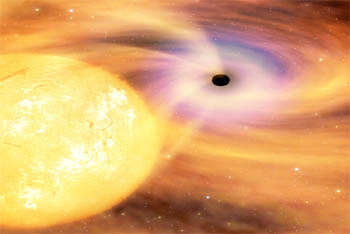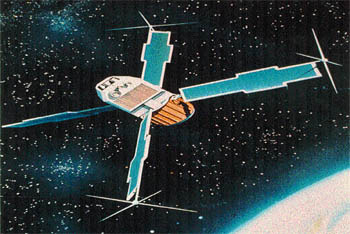Black Holes aren’t just made-up stuff in sci-fi movies – they may actually exist! So what exactly are they – and what are the chances of you ever coming across one in your lifetime?
A Star is Born
Stars are born every day. Just like people, these balls of hot gas grow up, get older and eventually die. Unlike people, stars shrink as they age. Inside a huge young star, hydrogen atoms crash into each other to form helium in a process called nuclear fusion, which releases huge amounts of energy. We see some of that energy as light. If we’re close enough to the star, we can also feel that energy as heat.
Battle Zone
A star is basically a battle zone its whole life. Not only does its own gravitational force attract anything nearby, it also pulls the star itself inward, trying to crush it into a super-dense, super-small mass. At the same time, the star’s nuclear engine gives off a huge amount of energy that pushes outward, counteracting the inward force of the star’s own gravity. As a result, the star doesn’t explode or collapse.
However, when a star starts to run out of hydrogen, there’s a lot less energy being given off to counteract the gravitational force that’s pulling inward. Eventually, the star collapses. The bigger the star, the smaller the mass it collapses to become when it dies.
Ashes, Ashes
When a mid-size star like our own sun dies, its gravitational force turns it into a heap of ash about the size of the Earth. Considering you could fit a million Earths into the sun, that’s a pretty small, extremely dense mass of stuff. But that’s nothing compared to what happens when a truly massive star collapses – the pressure is so huge that the star’s electrons actually get shoved into the nuclei of its atoms, where they react with the protons to form neutrons. The star, now made mostly of jammed-together neutrons, is called a Neutron Star, and it’s squeezed together so tightly that a golfball-sized piece of it would actually weigh as much as a billion elephants!
The Death of a Star: The Inside Story
When the biggest stars collapse, their gravitational pull becomes so huge that NOTHING can escape their pull – not even light. This makes them INVISIBLE, which is why they are called Black Holes. Anything and everything that comes near a black hole – gas, light, astronauts – gets sucked in, never to be seen again. A black hole is definitely not a good spot for a vacation!
If you’re confused about how light can be “sucked in” by gravity, think of it this way: On Earth, you can beat the pull of gravity if you travel fast enough – about 7 miles per second. This is how fast a spaceship must go in order to be launched. A black hole has such tremendous gravitational pull that in order to escape it you must travel at more than the speed of light, which is 186,000 miles per second. Nothing can go faster than light – not even light (of course!). That’s why a black hole is black. So how do we know it’s there?
Back in Black
In 1970, the satellite Uhuru came across a star called Cygnus 1 that was acting mighty strange, as though it were being dragged around by something that couldn’t be seen. This invisible something had the gravitational pull of 10 suns and appeared to be tearing gas away from the star. Yet, despite gobbling up all that bright, glowing gas, it did not glow. That was the first good piece of evidence for a black hole. Since then, lots more evidence has been collected by the Hubble Space Telescope.
Some astronomers think all this evidence that’s been collected means there are super-massive black holes made from millions of collapsed stars at the center of every galaxy. There may also be mini black holes the size of pencil points or peas! And some people even believe black holes are gateways to other universes. If that’s a door you think you may like to walk through, just be sure you’ve got a round-trip ticket!
Video: Black Holes
Related Stories:





































